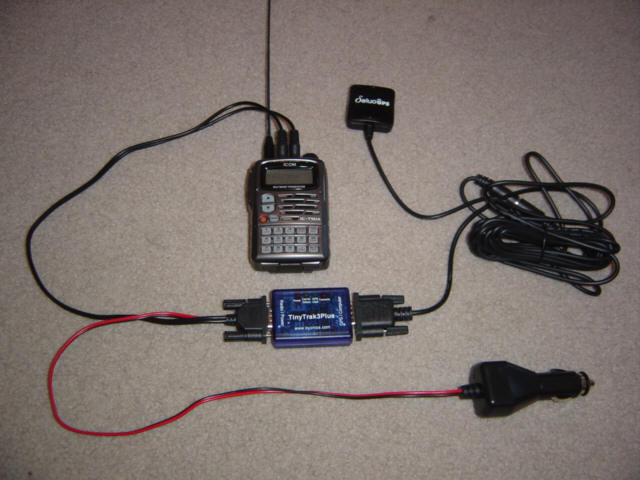

APRS stands for "Automatic Position Reporting System" - a technology originally developed by Amateur Radio Operators (HAMs). Basically, it is a system that combines GPS positioning, HAM radio, and Internet technology. If you would like to know more about the system itself, here is a good Resource Site. What I'll be describing here is the simplest implementation of APRS - a position reporting beacon.
A beacon system consists of three parts - a GPS receiver, a Terminal Node Controller (TNC) and a transmitter. The GPS receiver is obviously used to calculate the unit's exact location. I'm using an all-in-one device that has the antenna, position calculation chip, and data interface all contained in a 1.5"x1.5"x.5" unit. The GPS sends it's data to a TinyTrack3 controller that basically acts as both a modem and radio controller. It is programmed to send a short burst of digital information called a "packet" every few minutes. This packet is sent to the radio transmitter on a certain frequency that is picked up by numerous ground stations and internet gateways. The digital position information is then shared between several servers on the internet and/or used by APRS receivers, overlaid on a detailed map, and graphically presented to the user - anywhere in the world. Kewl, huh!?! My Amateur Radio call sign is "K5EXP", so that is what the tag says on my positon locator. This rig didn't work out in the airplane so it is now installed in the Explorer and uses a "truck" icon. I just installed a new tracker in the Berkut and it uses an "airplane" icon. You'll see what I mean when you check it out below...
The uses for this technology are many, but I have some specific uses in mind. I'm using it in both the Berkut and in my SUV when I'm out and about or on a long trip. That way, Sandy and the rest of the family can see where I am while storm spotting for Skywarn, position reporting use during HAM radio community service events or emergency services, and while zipping around in the Berkut. You can even watch me run the SARL races! This is mainly for information purposes and fun, however it can also be useful in a true emergency. Aircraft emergency beacons (ELTs) transmit a constant signal only after a crash that search and rescue folks have to electronically "home in" on...if they can receive the signal at all. That signal can be obstructed by terrain, transmitter/antenna damage, etc. and is relatively weak to begin with - hence, un-reliable. The APRS beacon continuously reports GPS coordinates every few minutes to multiple Internet servers that have no direct connection to the APRS transmitter - making this technology more accurate, redundant, and not reliant on a functioning transmitter post crash. At worst, search teams would know where to start looking - within a minute or two from the last reported position that the beacon sent. With increased accuracy comes increased safely...and that's a good thing any way you look at it.
UPDATE (1-15-08): The rig shown above was just a trial attempt and it had several "issues". It was bulky, heavy, and way too much radio for the job. So, I finally got around to installing a lighter, simpler, more permanent tracker in the Berkut. The entire system can be seen here. It works the same way, except the TNC and the 8-watt transmitter are on the same circuit board. Just add power and a GPS reciever and it's ready to go. The 9v battery is hooked up for testing/programming only, but I did use the connector to wire the unit to ship's power. I decided to instal the unit in the nose so that it is easily accessable and removable for programming. Initial testing showed that at the full 8-watts of power, the transmitter caused lots of RF noise on the audio circuits...not acceptable. No problem, I just turned the power down to about 1.5-watts and things are nice and quiet. Besides, there is no reason to be running full power up in the air...a 1-watt signal will carry many many miles. But, to further protect the unit and reduce noise, I slipped the transmitter unit into the plastic sleeve it was shipped in, and covered the sleeve with aluminum tape - making a shielded box. Here's what it looks like installed just under the nose door opening, and the antenna runs up into the forward compartment. The whole assembly weighs less than 6oz. and although I hate adding weight to an airplane, I think it is certainly worth it for this capability. Overall, the unit works perfectly! Have fun tracking Berkut 13's progress on the link above...but remember, I do have an "Off" switch when I want to be in "Stealth Mode". ;-)
 Back to the Proto-page
Back to the Proto-page